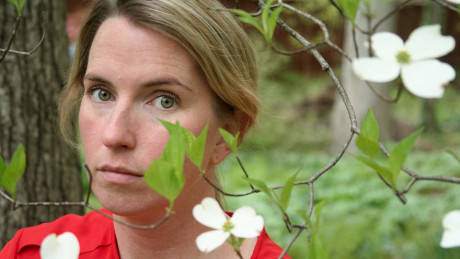Once the lights are up, After Eleven is relentless. With persistent intensity, Rebecca Roy delivers a monologue that switches from a mother character to that of a child who suffers with mental illness. Her eyes pierce empty space then gradually connect with each audience member in true compassion.
This new play by Graziella Jackson under the direction of Kate Debelack is a foray into the extreme twists and turns of life with mental illness as seen through the eyes of a child and their mom. The set is mostly bare with only a large bench and a white backdrop used for video projection. Both get used efficiently throughout the play – the bench as a place of repose or part of the child’s “jungle gym” and the projections are a metaphor or window onto both horrific events we recognize from the recent past merge with the more intimate and personal story of Matty Temper.
Clad in khaki pants, blue Keds, blue blouse and floral patterned scarf Jude Temper seamlessly shifts between characters through voice change, physical expression, and through simple creative uses of her scarf. These are some of the more memorable moments in this story – as she charges through the space, zipping and soaring like the boy’s favorite part in Peter Pan she shouts, “Look! I’m flying!”…the scarf transforms into wings in the child’s own “Neverland.” The contrast from extreme joy to somberness hooked me into the emotions of the monologue. Serious conflict ensues as Roy pushes the boy character to edgy limits, “I’ll cut your tongue out!” she screams at one point. For a slight moment characters seem to merge, we forget the back and forth rhythm of child to mom, mom to child – and we are thrust deeper into our role as witnesses. These parts were some of my favorites from both the director and the actor. By pushing into these extremes the story gains its credibility and true compassion surfaces. The child’s plaintive cry, “I’ll be good Mommy” still resonates the day after seeing this play.
Other poignant moments are when Roy paces, step after step in recitation of acronyms like “Ferpa, IEP, 504…” all social programs to assist special needs…the grid formation she makes takes on the feel of a cage or being locked in…much like being locked in to the illness, the “system”, the price of medication, the emotional toll of living with this haunting condition. She moves zombie-like through the bureaucratic maze that only seems to worsen both her and the boy’s situation.
A voice over and projected images are woven throughout the production by Sound Designer Karl Jackson. A child’s scrawl shines in the light. You can make out a sun, a smiling stick figure, then central to the drawing is a clump of lines, layer upon layer of them and they bury a small figure. It’s Matty’s “cave” where he’s put his “bad” self. We get that the child is “fatal to himself.” The proverbial writing is on the wall. Program notes say
Too many people with mental illness are treated through our judicial system –through incarceration. They fall through the cracks because of us.
After Eleven asks us to change.
Theater has this power. We witness, we transform. Out of darkness comes light.
This summer welcomes Dance Place as a Fringe venue – the new studio dedicated to Carla Perlo’s father, Hyman Perlo, is a perfect place for Fringe’s mission – giving voice to not so mainstream themes and creative expression. Debelack has an impressive litany of directorial credits and this solo performance adds to her body of work.
Running Time: 75 minutes.
After Eleven plays through Saturday, July 25, 2015 at Dance Place: Hyman M. Perlo Studio – 3225 8th Street NE, in Washington, DC. For more information and to purchase tickets, go to their Capital Fringe page.
RATING: THE BEST OF THE 2015 CAPITAL FRINGE





